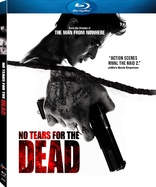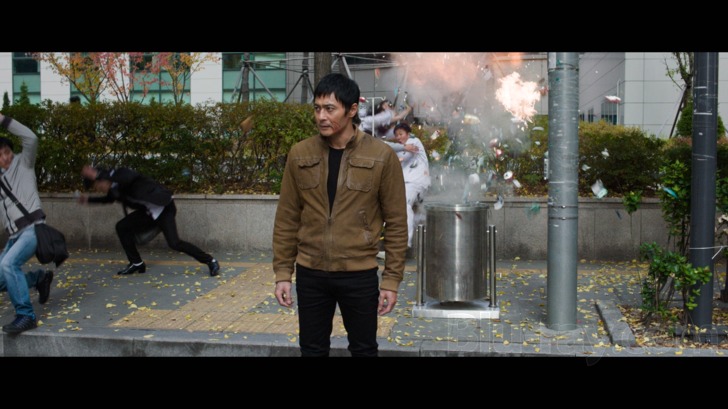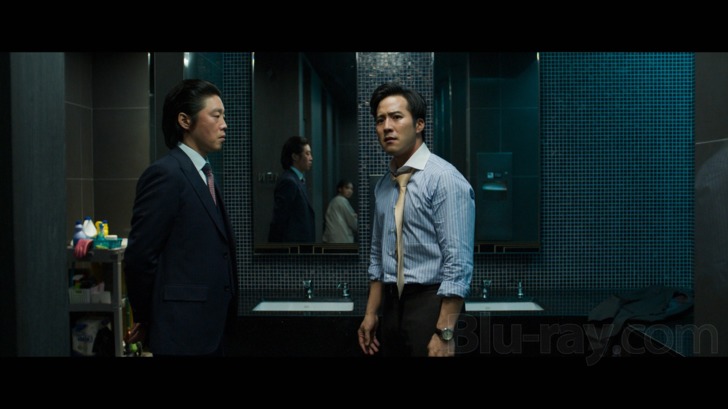No Tears for the Dead Blu-ray Movie
HomeNo Tears for the Dead Blu-ray Movie 
U-neun nam-ja / 우는 남자CJ Entertainment | 2014 | 116 min | Not rated | Feb 17, 2015

Movie rating
6.8 | / 10 |
Blu-ray rating
| Users | 0.0 | |
| Reviewer | 4.0 | |
| Overall | 4.0 |
Overview
No Tears for the Dead (2014)
Gon, a Korean raised in America, is a professional hitman who is usually flawless in taking out his targets. On his latest assignment, though, Gon makes the terrible mistake of killing an innocent young girl. Overcome by regret, guilt and shame, Gon no longer wants to kill for a living, but his boss orders him to go to Korean -- to eliminate the dead child's mother.
Starring: Jang Dong-gun, Kim Min-hee, Brian Tee, Kim Jun-seong, Kim Hee-wonDirector: Lee Jeong-beom
| Foreign | 100% |
| Crime | 3% |
| Action | 1% |
| Thriller | Insignificant |
| Drama | Insignificant |
Specifications
Video
Video codec: MPEG-4 AVC
Video resolution: 1080p
Aspect ratio: 2.39:1
Original aspect ratio: 2.39:1
Audio
English: DTS-HD Master Audio 5.1 (48kHz, 24-bit)
English: LPCM 2.0 (48kHz, 24-bit)
Korean: DTS-HD Master Audio 5.1 (48kHz, 24-bit)
Korean: LPCM 2.0
Subtitles
English
Discs
50GB Blu-ray Disc
Single disc (1 BD)
Packaging
Slipcover in original pressing
Playback
Region A (C untested)
Review
Rating summary
| Movie | 3.5 | |
| Video | 4.5 | |
| Audio | 4.5 | |
| Extras | 2.5 | |
| Overall | 4.0 |
No Tears for the Dead Blu-ray Movie Review
Cry for the Children
Reviewed by Michael Reuben February 17, 2015No Tears for the Dead ("NTFTD"), the third film by Korean writer/director Lee Jeong-beom, lacks the elegantly focused plot of his 2010 hit, The Man from Nowhere, but many of the thematic elements will be familiar to fans of that high-octane action thriller with a dark spiritual center. As in The Man from Nowhere, the hero of NTFTD has spent his life immersed in violence, his emotions locked deep inside as a result of childhood trauma of which the full extent is not fully revealed until the film's final moments. And as in the earlier film, an encounter with a little girl sends him on a quest for redemption that pits him against an army of criminals bent on his destruction. The difference in NTFTD is that the hero is one of the criminals—or, at least, he was until now.

Gon (Jang Dong-gun) is a Korean raised in America (Minnesota, or so he claims). His whole life as an adult has been about killing, at which he is an expert. He works for an L.A.-based Chinese Triad headed by Dai Ban (Dana Lee), and the closest thing he has to a friend is a top lieutenant in the organization known at Chaoz (Brian Ting, The Wolverine ). The chink in Gon's armor is little children, because he himself is an orphan, the product of a tragic backstory that explains why he lives in America. Children bring out the child hidden deep inside Gon, which is why he begins making faces, and leaves an origami swan as a gift, when he spots a little girl, later identified as Yumi (Kang Ji-woo), sitting in the nightclub where he is awaiting the arrival of his next target. As usual, Gon does not know the details, only that he has been ordered to stop a sale of stolen electronic data. He does the job with lethal efficiency, but there is unexpected collateral damage. The little girl, Yumi, is shot down along with the targets. (Note that this is not a spoiler; you can see it coming with the inevitability of a thunderstorm.) The experience sends Gon into a drunken spiral of despair, from which Chaoz and his men awaken him when he is summoned by their mutual boss. It turns out that Yumi was not at the nightclub by accident. Her mother, Mogyeong (Kim Min-hee), who works for a hedge fund in Seoul, South Korea, is somehow connected to the stolen data that was being sold when Gon blasted his way into the room. Just before the seller died, he e-mailed the data to one of three people. All of them must be interrogated, the data recovered, and the recipients killed. Mogyeong is Gon's responsibility. At least, says his boss, Dai Ban, you can finish the job by putting her out of her misery. And look on the bright side: You can visit your homeland after all these years. This basic setup for NTFTD is rich with the kind of moral quandaries that have given the best action thrillers depth and intensity ever since John Woo's The Killer. Lee offered similarly impossible choices for the mysterious "Mister" in The Man from Nowhere, but that film was a blockbuster success, whereas NTFTD proved a disappointment at the South Korean box office (a fact that director Lee acknowledges in the "Making of" featurette). Much of the reason, I suspect, is the sheer complexity of the plot, especially after the action shifts from L.A. to Seoul. A new arch-villain is introduced in the person of John Lee (Jun-seong Kim), head of the hedge fund where Mogyeong is a star analyst. Lee has his own squad of goons with tasks to perform. The fates of the other two recipients of e-mails from the deceased data thief must be tracked—one of them dies a spectacular death involving a truck—and an entire network of surveillance, counter-intelligence and hidden agendas surrounds Gon's mission. Also, a squad has been covertly dispatched from America to shadow Gon and, when he appears to be having second thoughts, eliminate him. The squad is led by Gon's friend Chaoz, and it packs enough firepower to overthrow a small country. When a plot becomes so overstuffed that, halfway through the film, you need to have a senior police detective come in and explain how everything fits together (on the pretext of educating Mogyeong about the danger facing her), it's a sure sign that the narrative has gotten too complex for its own good. To Lee's credit, he uses all of these extra characters in staging still more action set pieces, most of which involve Gon's formidable skills as a killing machine and make imaginative use of weaponry, vehicles, a variety of building spaces and architectural details, and the formidable athletic ability of both the stunt team and star Jang Dong-gun, who trained for months in both Korea and the U.S. to prepare for the role. Bullets hit, squibs explode, bodies and objects fly through the air, and Gon seems unfazed by injuries that would have killed a lesser mortal. He is, after all, a man on a mission. But protecting Mogyeong is only part of it. At his core, Gon believes he must atone for the sinful life that culminated in the death of Yumi, and merely saving her mother is not enough. In Gon's universe, the innocence of children is a sacred thing not to be trifled with, and we see in flashbacks how his own shattered childhood shaped his values. One critical part of the story emerges in a memory that Gon shares, but another is withheld until the very end of NTFTD, when it can register with the greatest impact. Jang's emotional performance in these scenes, alternately restrained and unbridled, is just as impressive as his physical prowess in embodying Gon's combat skills, and the pathos of Gon's quest ultimately rises above the busy plot to give NTFTD an authentically tragic dimension. The film will, I suspect, improve on repeat viewings, as director Lee suggests. It's certainly lively enough to be worth revisiting.
No Tears for the Dead Blu-ray Movie, Video Quality 

No Tears for the Dead was shot by Lee Mo-gae, who won the Asian Pacific Screen Award in 2008 for his stylish work on The Good, the Bad, the Weird. The film was shot digitally at 4k on a Sony CineAlta F65 and finished on a digital intermediate, from which CJ Entertainment's 1080p, AVC-encoded Blu-ray was presumably derived by direct digital conversion. In the "Making of" featurette, cinematographer Lee describes the challenge of finding the right camera speed for some of the physical effects dreamed up by the director and his stunt and practical effects teams, but he seems to have surmounted every obstacle, because the Blu-ray image is gorgeous: sharply detailed yet cinematic; anchored by deep blacks and dark shadows in scenes like the opening assassination in the basement of the nightclub; shiny, bright and business-like with chilly steel and glass in the hedge fund offices; and awash with colors in various settings like nightclubs, rooftops lit with fluorescent lights, hi-tech rooms filled with computer screens, and the kaleidoscopic cityscape of Seoul by day. Colors tend toward the saturated, the better to bring out the copious bloodshed, and the palette favors cool blues and greens, except in the flashbacks to Gon's childhood, where warmer tones dominate, or in Mogyeong's memories of Yumi, which are often hazy and dreamlike. CJ has mastered NTFTD with an average bitrate of 25.004 Mbps, using most of the BD-50 that isn't devoted to extras. It's a perfectly good rate, especially with digitally acquired material. Artifacts are not an issue.
No Tears for the Dead Blu-ray Movie, Audio Quality 

NTFTD comes with a choice of four lossless audio tracks, two Korean and two English. Even the original Korean tracks have large sections of English dialogue because of the film's international cast and because its hero was raised in America. (Gon's conversations with his friend, Chaoz, switch back and forth between English and Korean.) The Blu-ray defaults to an English 5.1 track with the actors' voice dubbed so that all of the dialogue is spoken in English. The viewer can manually select the original Korean 5.1 track. Both are in DTS-HD MA, and I greatly prefer the original Korean, simply because the lip movements always fit the sounds coming from the actors' mouths. The disc also has PCM 2.0 tracks in both English and Korean, but the 5.1 track is the way to go. It has all the energy and directionality one would expect from a modern action film, with bullets and bodies flying, glass shattering, bones crunching, blades slicing, cars roaring and colliding, and various usually immobile items of architecture crashing to the floor or ground. The English dialogue is clear enough that I presume the Korean dialogue to be equally intelligible. The alternately energetic and mournful score, with its distinctive Latin guitar at key moments, is by Choi Yong-rak (The Chaser).
No Tears for the Dead Blu-ray Movie, Special Features and Extras 

- Making of No Tears for the Dead (1080i; 1:78:1; 27:12): The director, cinematographer, stunt coordinator and other crew members discuss in detail the challenges behind several of the film's major sequences, including the melding of practical and visual effects.
- Deleted Scenes (1080p; 2.39:1; 6:51): The three scenes are not separately listed or selectable. The first two are the most significant, because they relate to a deleted subplot that would have extended Gon's backstory.
- Director's "Commentary" (1080i; 1.78:1; 3:19): I have added quotation marks to the word "commentary", because this isn't what the term usually means on a Blu-ray or DVD. This is simply a short featurette containing interviews with writer/director Lee and members of his creative team discussing his vision for the film.
- Brian Tee Interview (1080i; 1.78:1; 2:05): Speaking in English, Tee discusses his character, his director and the film's star.
- Character Spot—Mogyeong (1080i; 2.39:1; 0:51): A promotional spot focusing on the lead female character.
- Character Spot—Gon (1080i; 2.39:1; 0:52): A promotional spot focusing on the hero.
- Behind the Scenes (1080i; 1.78:1; 3:19): The featurette is also promotional in nature, but it includes some good rehearsal and on-set footage, as well as brief interviews with the director and his two leads.
- Action Highlights (1080p; 2.39:1; 2:01): This short presentation, which is also promotional in nature, assembles major action beats from throughout the film.
- Trailers (1080p)
- No Tears for the Dead
- The Divine Move
- Friend II: The Legacy
- The Admiral: Roaring Currents
No Tears for the Dead Blu-ray Movie, Overall Score and Recommendation 

Underneath the elaborate plot mechanics, NTFTD tells a story of lost innocence and asks whether it can ever be recovered. Gon clearly doesn't think so, but that doesn't stop him from disobeying his long-time boss to do something that he feels he must, not so much for the mother of the child whose death he caused, but as a reckoning with his own past. As the film's closing scenes make clear, Gon has been holding back a deep sorrow, a private grief, for so long that he no longer knows how to face it. His quest to save Mogyeong and provide justice for her daughter may bring him relief, but not salvation. In one of our last views of Gon, he is illuminated in a glass-enclosed elevator descending the exterior of an office building, heading down into darkness. It's an elaborate shot that, as the disc's extras reveal, took extensive effort to create, but the reason for it is unmistakable. Gon is a tragic figure, because his journey has only one possible destination. Highly recommended.
Similar titles
Similar titles you might also like

The Stone Killer
Limited Edition to 3000
1973

Return of the Dragon
The Way of the Dragon | 猛龍過江 | Collector's Edition
1972

Bullhead
Rundskop
2011

The Raid 2
The Raid 2: Berandal
2014

Doberman Cop
ドーベルマン刑事 / Doberuman deka
1977

Merantau
2009

Violent Cop
その男、凶暴につき
1989

Female Prisoner #701: Scorpion
1972

Zero Woman: Red Handcuffs
Zeroka no onna: Akai wappa
1974

The Killer
喋血雙雄 / Dip huet seung hung
1989

The Man from Nowhere 4K
아저씨
2010

The Connection
La French
2014

Run All Night
2015

The Villainess
악녀
2017

Special ID
2013

Outrage
アウトレイジ / Way of the Yakuza
2010

Dead or Alive 2
2000

Shaolin
新少林寺
2011

Dragnet Girl
非常線の女
1933

Pieta
피에타
2012